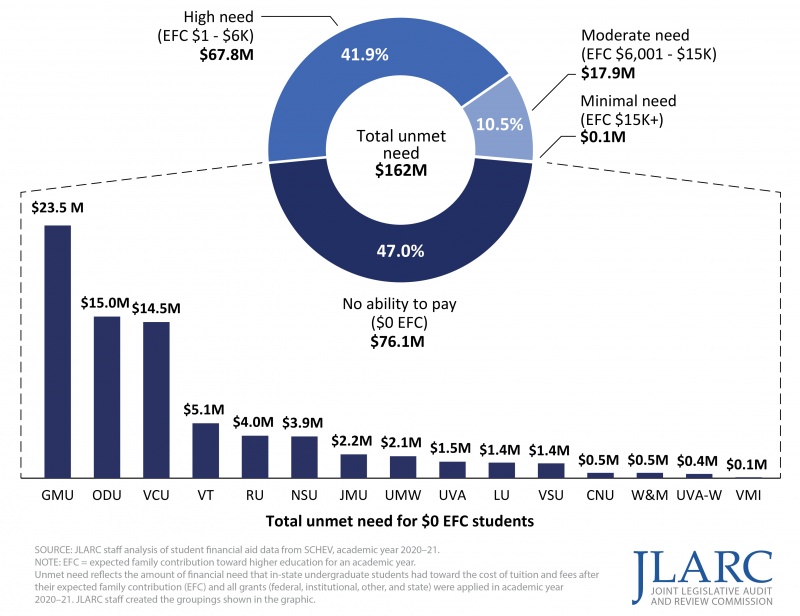Higher Education Financial Aid Grant Programs and Awards

WHY WE DID THIS STUDY
In 2022, JLARC approved a study resolution directing JLARC staff to review the effectiveness and adequacy of Virginia’s financial aid policies and practices.
ABOUT VIRGINIA’S STATE STUDENT FINANCIAL AID GRANT PROGRAMS
Virginia directs financial aid to assist students and their families with covering a portion of the cost of higher education tuition and fees. Under the state’s two main programs—VGAP and the Commonwealth Award—over 37,000 students received nearly $172 million in 2020–21. The average award for VGAP was $5,964, while the average Commonwealth Award was $3,679. Virginia has several smaller state financial aid grant programs—not addressed in this report—which aim to aid specific student populations attending public institutions. These grants served over 7,600 in-state undergraduate students in 2020–21.
WHAT WE FOUND
In-state undergraduate students have substantial unmet financial need and debt
Financial aid has not kept pace with rising higher education costs and the declining amount that families are able to pay toward those costs. Average state financial aid grant awards increased 47 percent over the last 10 years, compared with a 33 percent increase in tuition and fees, adjusted for inflation. Even though more financial aid is available, the average family can contribute less funding to higher education, and financial aid grants are spread across a growing number of students with no ability to pay for higher education.
After all federal, state, institutional, and third-party financial aid grants are applied, in academic year 2020–21 over 33,000 in-state undergraduate students attending Virginia’s public four-year institutions had $162 million in unmet financial need for tuition and fees. Students with no ability to pay for higher education accounted for nearly half of this amount. Students’ unmet financial need was significantly higher ($977 million) when considering the total cost of attending higher education (e.g., tuition and fees plus room, board, books, and supplies).
The majority of in-state undergraduate students who graduated from Virginia’s public four-year institutions in academic year 2020–21 had debt when they graduated. Debt averaged nearly $30,000 per student and totaled $537 million statewide.
Students at Virginia’s access institutions, including Historically Black Colleges and Universities, have more unmet financial need than most other Virginia institutions
Students attending “access” institutions (institutions that have less stringent admissions criteria) accounted for nearly three-quarters of the total unmet financial need in academic year 2020–21. Students who graduate from access institutions also have high levels of student debt, accounting for nearly half of the total statewide cumulative debt for in-state undergraduate students at the time of their graduation in academic year 2020–21.
Virginia State University (VSU) and Norfolk State University (NSU) charge lower tuition and fees than other Virginia public four-year institutions, yet their students have higher unmet financial needs. VSU and NSU had 13 percent of the state’s in-state undergraduate students with no ability to pay for higher education. Students with no ability to pay for college at VSU and NSU had a combined unmet need of $5.3 million in academic year 2020–21, more than the total unmet need for students with no ability to pay at all but three other institutions. Students who graduated from VSU and NSU in academic year 2020–21 had a combined total student debt of $32 million at the time of their graduation.
In-state undergraduate students had $162 million in unmet need after all aid was applied, 2020-21

Financial challenges affect students’ academic success, and along with a greater inability to afford higher education costs and significant levels of student loan debt, VSU and NSU students had especially low six-year graduation rates. Virginia’s other “access” institutions (institutions that have less stringent admissions criteria) have similarly low six-year graduation rates, but graduation rates are lowest at VSU and NSU, 43 percent and 32 percent, respectively. Research indicates that financial aid is an important tool for helping students who have financial need complete their education, and the General Assembly has recently appropriated additional financial aid funds to VSU and NSU through the Virginia College Affordability Network program.
State financial aid eligibility criteria are overly stringent, administratively burdensome, and difficult for students to understand
Virginia has two primary financial aid grant programs—the Virginia Guaranteed Assistance Program (VGAP) and the Virginia Commonwealth Award (Commonwealth Award) program. These two programs account for over 95 percent of state financial aid funds spent in academic year 2020–21. The additional requirements that VGAP recipients must meet—maintaining continuous full-time enrollment and progressing a full class level each year, having a minimum high school GPA of 2.5, and maintaining a minimum college GPA of 2.0—prevent many students from accessing state financial aid. Institutions estimated that, of the nearly 15,000 students receiving VGAP in 2020–21, more than half lost VGAP eligibility because of the full-time enrollment and progression requirements. Furthermore, 2 percent of in-state undergraduate students had a high school GPA below 2.5, making them ineli-gible for VGAP. These requirements are contrary to subject matter experts’ recommendations to minimize financial aid grant eligibility criteria and are administrative-ly burdensome for financial aid staff.
Having two separate grant programs causes confusion among students, because they have to understand two separate sets of eligibility criteria and award amounts. Two grant programs also increase the workload of financial aid staff because they have to switch students between programs as student eligibility changes, instead of using a single set of grant criteria.
Virginia’s approach to allocating grant funding to institutions underfunds students’ financial need at some institutions
The state has provided insufficient funding for several institutions to award state VGAP or Commonwealth Award grants to their neediest students. The state allocated $174.8 million in grant funding in academic year 2020–21 to Virginia’s 15 public four-year institutions, but eight institutions did not receive enough funding to meet the financial needs for their neediest students. For example, George Mason University needed an additional $35.7 million to meet the financial needs of its neediest students.
The amount of state financial aid grant funds institutions receive is based on a formula developed and used by staff at the State Council of Higher Education for Virginia (SCHEV), and elements of this formula lead to an inefficient distribution of state aid dollars. For example, SCHEV’s formula does not account for the endowment funds that institutions use for financial aid because of existing state law, which results in institutions with larger endowment resources receiving state aid dollars that could instead be allocated to other institutions.
Institutions’ practices for awarding state aid do not consistently prioritize students with the most financial need
Currently, Virginia’s public four-year institutions have different policies and practices for awarding VGAP and Commonwealth Award grants. Each institution adopts its own financial aid “schedules” that stipulate: the basis for measuring students’ financial need (e.g., based on income level, EFC, or remaining need), student eligibility for state grants, and the maximum state grant awards. Under this model, students with similar financial need at different institutions receive different state grant awards. For example, students with no ability to pay for higher education received a median VGAP award covering 33 percent of tuition at George Mason University, 71 percent of tuition at Virginia State University, and 83 percent of tuition at the University of Virginia.
With the discretion that institutions are given to develop their own awarding schedules, some have directed state financial aid to students with moderate and minimal financial need even though students with no ability to pay still had remaining need after all aid sources are applied. Institutions awarded a total of $31.2 million in state grants to students with moderate financial need and $5.8 million to those with minimal financial need in academic year 2020–21.
WHAT WE RECOMMEND
Legislative action
- Amend the Code of Virginia to allow students enrolled in at least six credit hours to receive prorated VGAP financial aid grants.
- Amend the Code of Virginia to require recipients to meet satisfactory academic progress requirements set by their institution, instead of VGAP’s different GPA requirements.
- Amend the Code of Virginia to require public higher education institutions to calculate state financial aid grant awards after subtracting federal Pell grant awards.
- Amend the Code of Virginia to combine VGAP and the Commonwealth Award so that there is one primary state student financial aid grant program.
- Amend the Code of Virginia to prioritize state financial aid grants for students with the most financial need, either by (i) establishing a financial aid awarding schedule for state grants that would be used uniformly by all institutions or (ii) restricting institutions from awarding state grants to students with a higher ability to pay for higher education costs.
POLICY OPTIONS FOR CONSIDERATION
Legislative action
- Amend the Code of Virginia to allow past financial aid awards that were funded through endowments at public higher education institutions to be factored into state financial aid grant funding decisions.
- Direct the State Council of Higher Education for Virginia (SCHEV) to either (i) design and implement a financial aid awarding schedule for state grants that would be used uniformly by all institutions or (ii) restrict institutions from awarding state grants to students with higher ability to pay for higher education costs, based on expected family contribution or other similar metric.
The complete list of recommendations is available here.

